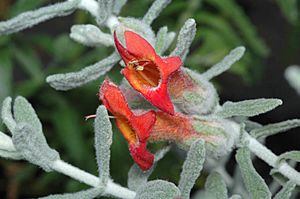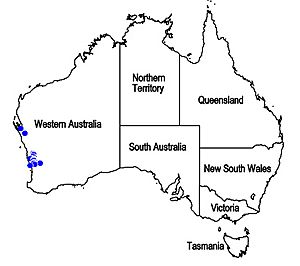Quoya dilatata facts for kids
Quick facts for kids Quoya dilatata |
|
|---|---|
 |
|
| Scientific classification | |
| Genus: |
Quoya (plant)
|
| Species: |
dilatata
|
 |
|
| Synonyms | |
|
|
Quoya dilatata is a unique flowering plant. It belongs to the mint family, called Lamiaceae. This plant grows only in Western Australia. It is a small, spreading bush. Its branches and leaves are covered in soft, white, woolly hairs. The leaves look a bit crinkly. Its flowers are shaped like tubes and are orange-red. They are also hairy on the outside.
Contents
Meet the Quoya Dilatata Plant
Quoya dilatata is a spreading shrub. It usually grows about 30 to 60 centimeters (12 to 24 inches) tall. Its branches and leaves are covered in a thick layer of white, woolly hairs. This makes the plant feel soft.
Leaves of the Plant
The leaves of Quoya dilatata are shaped like an egg or a spoon. They are about 1.5 to 3 centimeters (0.6 to 1.2 inches) long. They are also about 7 to 11 millimeters (0.3 to 0.4 inches) wide. The top surface of the leaves looks wrinkled or crinkly. The bottom surface has a network of veins.
Flowers and How They Grow
The flowers usually grow one by one. They appear in the upper part of the leaf stems. This forms a long, leafy spike of flowers. Each flower has a thin, hairy stalk. This stalk is about 2 to 4 millimeters (0.08 to 0.16 inches) long.
Flower Parts
Each flower is surrounded by small, leaf-like parts. These are called bracts and bracteoles. They are woolly and hairy on their lower side. But they are smooth on the upper side. The flower has five sepals. Sepals are like small leaves that protect the flower bud. These sepals are 8 to 12 millimeters (0.3 to 0.5 inches) long. They are spoon-shaped. They join together at their base to form a short tube. The sepals are thin and very hairy on the outside. They are smooth on the inside.
Petals and Stamens
The petals are the colorful parts of the flower. They are orange-red. They are 20 to 25 millimeters (0.8 to 1.0 inches) long. They form a tube that gets wider towards the end. This tube has five lobes, or sections. The tube is very hairy on the outside. It is smooth inside, except for a ring of hairs near the ovary. The lowest petal lobe is the biggest. It is egg-shaped and about 5 to 7 millimeters (0.2 to 0.3 inches) long. It is also 4 to 6 millimeters (0.16 to 0.24 inches) wide. The other four lobes are about the same size. Two lobes stand upright. The other two are on each side of the tube's end. The flower has four stamens. Stamens are the parts that produce pollen. They stick out beyond the petal tube. The lower pair of stamens is longer than the other pair.
When Quoya Dilatata Flowers
This plant flowers in September, October, or November. After flowering, it produces fruit. The fruit is almost round. It is about 2 to 3 millimeters (0.08 to 0.12 inches) across. The fruit is very hairy. The sepals stay attached to the fruit.
Plant Naming and History
This plant was first officially described in 1868. A scientist named Ferdinand von Mueller gave it the name Chloanthes dilatata. He published his description in a book called Fragmenta phytographiae Australiae. He used a plant sample collected by James Drummond near the Murchison River.
In 1870, another scientist, George Bentham, changed its name to Pityrodia dilatata. But in 2011, Barry Conn and Murray Henwood changed the name again. They called it Quoya dilatata. They published this change in a science journal called Australian Systematic Botany. The second part of its name, dilatata, is a Latin word. It means "spread" or "expanded." This describes how the plant grows.
Where Quoya Dilatata Lives
Quoya dilatata mostly grows between Perth and Carnamah in Western Australia. It has also been found near Northam and Cowcowing. These areas are part of different natural regions. These regions include the Avon Wheatbelt, Geraldton Sandplains, Jarrah Forest, and Swan Coastal Plain. The very first sample of this plant was found near the Murchison River.
Is Quoya Dilatata Protected?
The Western Australian Government's Department of Parks and Wildlife has classified Quoya dilatata as "not threatened." This means it is not currently in danger of disappearing.

